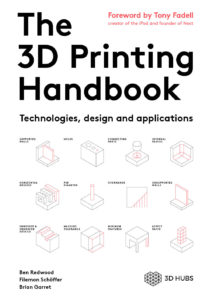 Title: The 3D Printing Handbook
Title: The 3D Printing Handbook
Authors: Ben Redwood, Filemon Schöffer, Brian Garret
Designer: Multitude
Genre: Business
Graphics: The first thing to note about this cover is that the words and images float, anchorless, because the background is white and the cover has no border. At Amazon a light rule and drop shadow have been added, but here the elements seem unbounded. Imagine what a difference changing the background to, say, yellow would make in visualizing the cover’s boundaries.
The graphics consist of twelve basic engineering shapes. Each has a highlighted red part and a caption. The second item in the second row, for example, is captioned “pin diameter,” and the part in red is the pin.
To convey that bit of information to you I had to go to Amazon, click on the cover, expand it to its greatest size, and squint, because even then the captions are hardly legible. Some of them I still can’t make out. Perhaps they can be read on the paperback version of the book, but on the ebook cover the words are hopelessly small.
Even the engineering shapes are difficult to make out. Their lines are thin, and the red parts don’t pop. Instead of using twelve such shapes, it would have been better to use as few as three, each being several time larger than what we see and perhaps each without red and without text. Better yet would have been an actual photo of something produced by 3-D printing.
The graphic that most catches the eye isn’t any of the twelve shapes but a thirteenth shape in the lower righthand corner: the logo for the publisher. That should be relegated to the spine of the paperback and to the title page or credits page of the ebook and paperback.
Typography: The title could be in a sprightlier font. The article, “The,” doesn’t add information, and it sits awkwardly above the other words.
The subtitle, “Technologies, design and application,” is fine in terms of information but weak in terms of layout. Each word of the title is capitalized; each word of the subtitle, other than “and,” also should be capitalized.
Missing is an Oxford comma, which should follow “Design.” With the Oxford comma, it appears that three independent things are listed. Without it, it appears that the second and third things recapitulate the first—that is, that “design” and “applications” are subsumed under “technologies.”
Many people don’t appreciate the utility of the Oxford comma. As a reminder to themselves, they may want to memorize these sentences: “Let’s eat Grandma. Let’s eat, Grandma.” Something as small as a comma can change the whole sense of an expression.
The only text appearing in color is the notice of the foreword. Its writer may be well known to the people for whom this book was written, but the use of red draws the eye to a secondary element. I would have placed the foreword notice in black at the bottom of the cover, where there would be plenty of space for it in a larger size, so long as the logo were removed and the author names moved to the top.
As for the author names, here they are the smallest text of all, outside of the graphic. The names should be moved to the top and put on one line, in a condensed and bolded version of the font. That would make them legible. Usually the author name is the second-largest text on a cover, and that convention should be kept here. Granted, these three authors may not be widely known, even to people in the industry, but they ought to be given proper credit.
Overall: Technical books by their nature are written for small audiences. No matter how fine its cover or how winsome its writing, a book such as this never will appear on a bestsellers list. Its purpose isn’t to delight but to instruct—and to instruct a few rather than many. Such books commonly end up with uninspiring covers, perhaps on the rationale that those who might be interested in the topic will purchase the book no matter how it looks.
For some that no doubt is true, but other buyers may take a pass on a book the cover of which appears slapdash, thinking that the content also will be slapdash. Such buyers will hunt around for an alternative book or, if none exists, for compensating information online.
There is no good reason not to make even a technical book—or any book for which the anticipated audience is expected to be small—look nice. Often it takes little effort to transform a cover such as this one into a cover that pleases even if it doesn’t delight.
Self-publishers and small publishers can make use of pre-made covers that have attractive graphics and placeholding text. While perhaps not as good as bespoke covers, where every element can work toward a desired effect, these pre-made covers provide books an aura of professionalism that covers such as the one critiqued here just don’t have.
